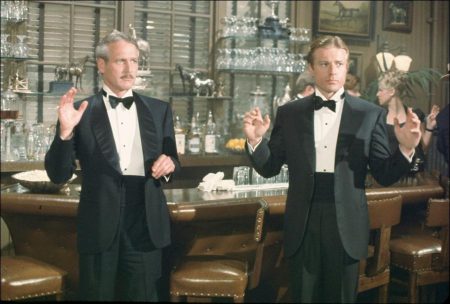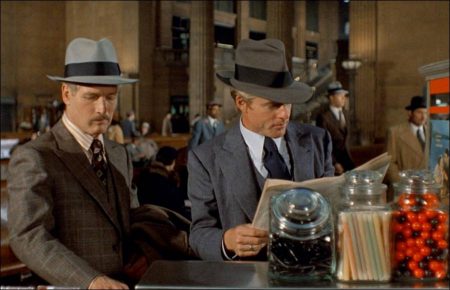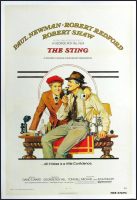Taglines: …all it takes is a little Confidence.
The Sting movie storyline. It’s September, 1936. The place: Joliet, Illinois. Luther Coleman, his apprentice Johnny Hooker, and their underling Joe Erie’s latest swindle has netted them $11,000, enough for an aged Luther to contemplate retiring from grifting. They are unaware however that that money belonged to ruthless racketeer Doyle Lonnegan, whose thugs kill Luther in retaliation.
Before Luther’s death, he suggested to Hooker that he contact Henry Gondorff, his old friend in Chicago to learn the art of the big con. Hooker does contact Gondorff, who has retired after being burned in his last big con. Gondorff decides to come out of retirement solely to help Hooker get back at Lonnegan for Luther’s murder. In pulling off the big con, Gondorff and Hooker require the assistance of a number of Gondorff’s old associates as well as a number of small time grifters. In the latter group includes Erie, who wants to do his small part in revenging Luther’s death.
Beyond Lonnegan or anyone else finding out about the con, there are many potential obstacles in pulling off the sting, such as a controlling and overly cautious Lonnegan wanting to do things his own way, and a number of people chasing after Hooker, including a crooked Joliet vice cop named Snyder, Lonnegan’s lower level thugs and a hired hit man. Through the process, Hooker, who sees himself as being a wheeler dealer, may come across a better deal than that provided to him by Gondorff.
The Sting is a 1973 American caper film set in September 1936, involving a complicated plot by two professional grifters (Paul Newman and Robert Redford) to con a mob boss (Robert Shaw). The film was directed by George Roy Hill, who had directed Newman and Redford in the western Butch Cassidy and the Sundance Kid. Created by screenwriter David S. Ward, the story was inspired by real-life cons perpetrated by brothers Fred and Charley Gondorff and documented by David Maurer in his 1940 book The Big Con: The Story of the Confidence Man.
The title phrase refers to the moment when a con artist finishes the “play” and takes the mark’s money. If a con is successful, the mark does not realize he has been cheated until the con men are long gone, if at all. The film is played out in distinct sections with old-fashioned title cards drawn by artist Jaroslav “Jerry” Gebr, the lettering and illustrations rendered in a style reminiscent of the Saturday Evening Post.
The film is noted for its anachronistic use of ragtime, particularly the melody “The Entertainer” by Scott Joplin, which was adapted (along with others by Joplin) for the film by Marvin Hamlisch (and a top-ten chart single for Hamlisch when released as a single from the film’s soundtrack). The film’s success created a resurgence of interest in Joplin’s work.
Released on Christmas Day of 1973, The Sting received universal acclaim and was hugely successful at the 46th Academy Awards, being nominated for ten Oscars and winning seven, including Best Picture, Best Director and Best Writing (Original Screenplay). In 2005, The Sting was selected for preservation in the U.S. National Film Registry of the Library of Congress as being “culturally, historically, or aesthetically significant.”
The Sting (1973)
Directed by: George Roy Hill
Starring: Paul Newman, Robert Redford, Robert Shaw, Charles Durning, Eileen Brennan, Ray Walston, Harold Gould, Dimitra Arliss, Robert Earl Jones, James Sloyan, Charles Dierkop
Screenplay by: David S. Ward
Cinematography by: Robert Surtees
Film Editing by: William Reynolds
Costume Design by: Edith Head
Set Decoration by: James W. Payne
Art Direction by: Henry Bumstead
Distributed by: Universal Pictures
Release Date: December 25, 1973
Visits: 94


